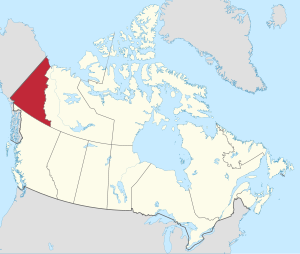Yukon
The Yukon is a Canadian territory (as opposed to a province), contiguous to Alaska, established in 1898 when the Yukon Territory Act was enacted. Although officially bilingual (English and French), the Yukon government also recognizes First Nations languages. The Yukon was part of the Canadian Federation, and governance of the territory was done through the federal government. James Walsh was appointed as the territories first commissioner in 1897. In 1898, land surveyor William Ogilvie took over as commissioner.
Whitehorse is the territorial capital, and the majority of Yukon residents reside in Whitehorse. The Yukon is the smallest and westernmost of Canada's three territories[1]. It is the most densely populated territory in Canada, with a population of 45,750 as of 2024, though it has a smaller population than all provinces. Whitehorse, the territorial capital, is the largest settlement in any of the three territories.[2]
The federal government's Yukon Act, which received royal assent on March 27, 2002, established "Yukon" as the territory's official name, although Yukon Territory remains in popular usage. Canada's mail system, Canada Post, uses the territory's internationally approved postal abbreviation of YT.[3][4] In 2021, territorial government policy was changed so that "The Yukon" would be recommended for use in official territorial government materials.[5]
At 5959 m, Yukon's Mount Logan in Kluane National Park and Reserve is the highest mountain in Canada and the second-highest on the North American continent (after Denali in Alaska). Most of the Yukon has a subarctic climate, characterized by long, cold winters and brief, warm summers. The coastal area along the Arctic Ocean has a tundra climate.
The territory's rivers include the Yukon River, the Pelly, the Stewart, the Peel, the White River, the Liard River, and the Tatshenshini River.
Attribution
- Some content on this page may previously have appeared on Wikipedia.
Footnotes
- ↑ See Wikipedia for information on [[Wikipedia:Provinces and territories of Canada#Territories|the three Canadian territories].
- ↑ Canada, Government of Canada, Statistics (February 8, 2017). Population and Dwelling Count Highlight Tables, 2016 Census (en).
- ↑ Table 8 Abbreviations and codes for provinces and territories, 2011 Census. Statistics Canada (December 30, 2015).
- ↑ Yukon Act, SC 2002, c 7. CanLII.
- ↑ Back to 'the' Yukon: The big return of a 3-letter word. CBC (August 10, 2021).
- The Canadian Encyclopedia https://www.thecanadianencyclopedia.ca/en/article/yukon
- Encyclopedia Britannica https://www.britannica.com/place/Yukon-territory<
